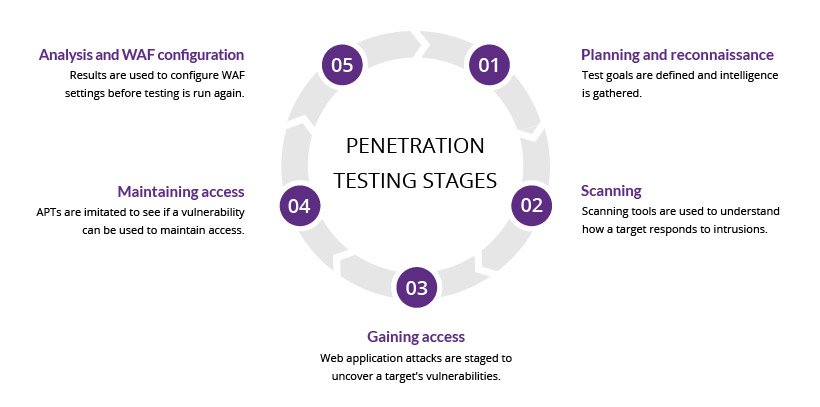Penetration Testing

A penetration test, also known as a pen test, is a simulated cyber attack against your computer system to check for exploitable vulnerabilities. In the context of web application security, penetration testing is commonly used to augment a web application firewall (WAF).
Pen testing can involve the attempted breaching of any number of application systems, (e.g., application protocol interfaces (APIs), frontend/backend servers) to uncover vulnerabilities, such as unsanitized inputs that are susceptible to code injection attacks.
Insights provided by the penetration test can be used to fine-tune your WAF security policies and patch detected vulnerabilities.
Penetration testing stages
The pen testing process can be broken down into five stages.

1. Planning and reconnaissance
The first stage involves:
- Defining the scope and goals of a test, including the systems to be addressed and the testing methods to be used.
- Gathering intelligence (e.g., network and domain names, mail server) to better understand how a target works and its potential vulnerabilities.
2. Scanning
The next step is to understand how the target application will respond to various intrusion attempts. This is typically done using:
- Static analysis – Inspecting an application’s code to estimate the way it behaves while running. These tools can scan the entirety of the code in a single pass.
- Dynamic analysis – Inspecting an application’s code in a running state. This is a more practical way of scanning, as it provides a real-time view into an application’s performance.
3. Gaining Access
This stage uses web application attacks, such as cross-site scripting, SQL injection and backdoors, to uncover a target’s vulnerabilities. Testers then try and exploit these vulnerabilities, typically by escalating privileges, stealing data, intercepting traffic, etc., to understand the damage they can cause.
4. Maintaining access
The goal of this stage is to see if the vulnerability can be used to achieve a persistent presence in the exploited system— long enough for a bad actor to gain in-depth access. The idea is to imitate advanced persistent threats, which often remain in a system for months in order to steal an organization’s most sensitive data.
5. Analysis
The results of the penetration test are then compiled into a report detailing:
- Specific vulnerabilities that were exploited
- Sensitive data that was accessed
- The amount of time the pen tester was able to remain in the system undetected
This information is analyzed by security personnel to help configure an enterprise’s WAF settings and other application security solutions to patch vulnerabilities and protect against future attacks.
